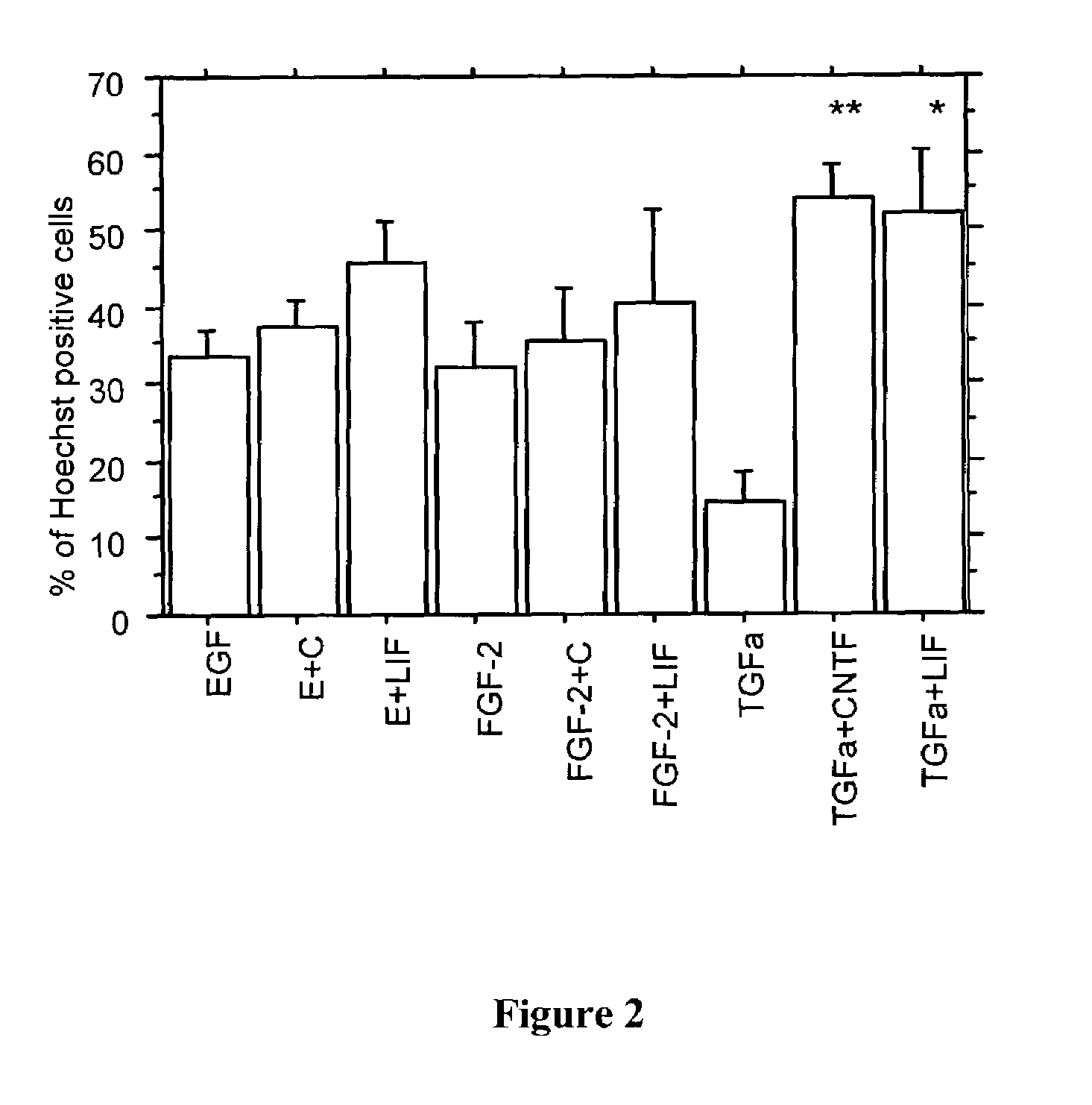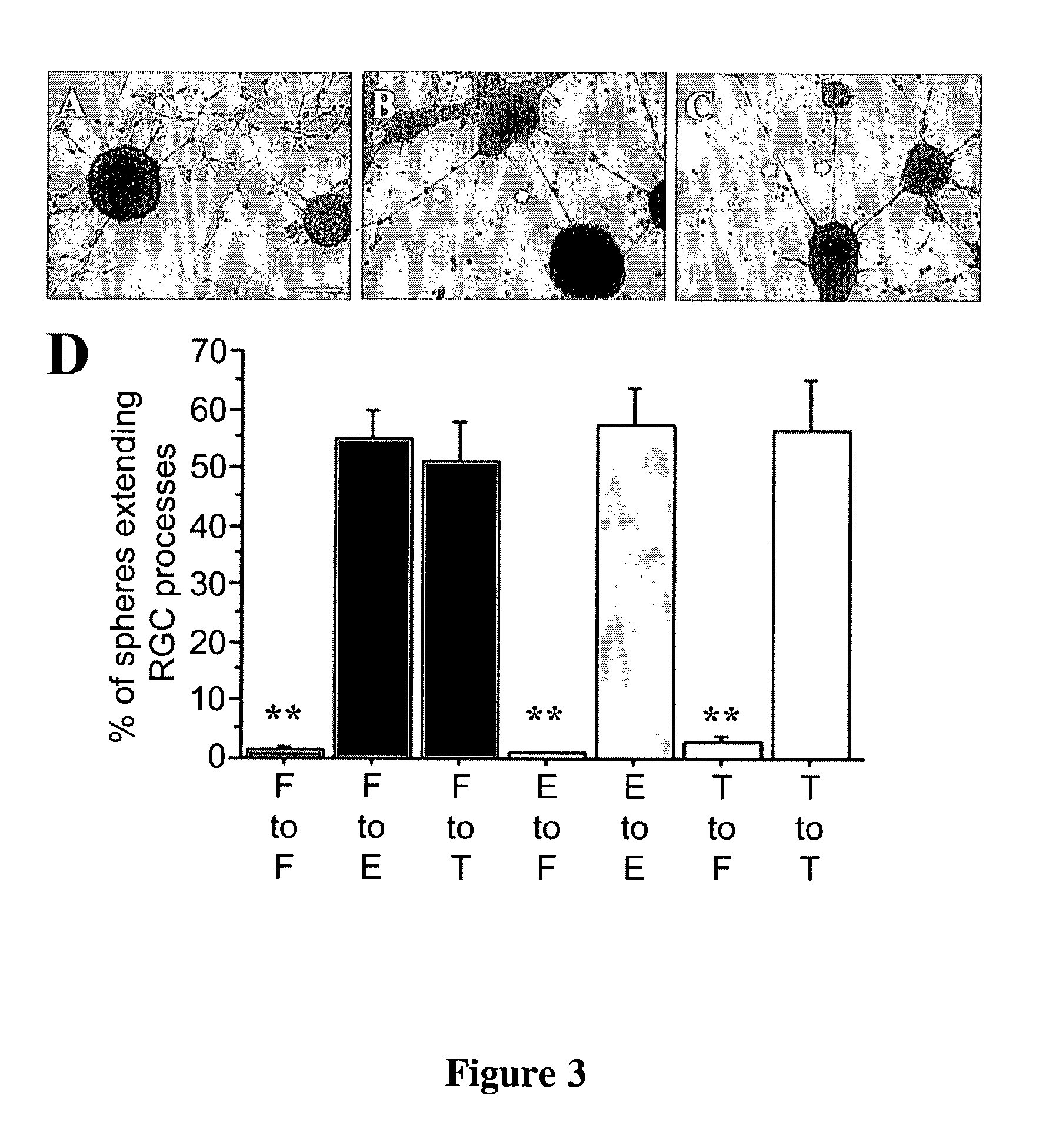Production of radial glial cells
a technology of radial glial cells and rc2+nestin, which is applied in the direction of nervous system cells, growth factors/regulators, animal/human proteins, etc., can solve the problem that adult mammalian brains are not capable of regenerating neurons, and achieve the effect of increasing the percentage of presumptive radial glial cells, increasing the percentage of rc2+nestin co-expressing cells, and increasing the percentage of presump
- Summary
- Abstract
- Description
- Claims
- Application Information
AI Technical Summary
Benefits of technology
Problems solved by technology
Method used
Image
Examples
example 1
Generation of Radial Glial Cells From Neural Stem Cells
[0099]In order to assess the ability of EGF, TGFα, and FGF-2+HS to modulate the generation of radial glial cells from NSCs, neurospheres were generated from the E14 ganglionic eminence, a time point at which radial glial fibers reach their maximum density in the cortical wall, and NSCs which respond to each of the mitogens are present. Primary neurospheres were generated in the presence of 20 ng / ml of EGF, TGFα, or FGF-2. Two μg / mL of HS was added to FGF-2 cultures. After 7 days in culture, neurospheres were passaged into identical growth conditions to enhance clonality. Following a further 7 days in culture, spheres were dissociated with a brief trypsin-EDTA treatment and mechanical dissociation with a fire-polished pipet. Dissociated cells were plated onto poly-L-ornithine coated coverslips at a density of 200,000 cells / coverslip, and allowed to settle for 30 minutes, after which time they were fixed in 4% paraformaldehyde. Ce...
example 2
The Effect of LIF and CNTF
[0101]Primary neurospheres grown in the presence of FGF-2+HS, EGF, or TGFα for 7 days were passaged into identical growth conditions in the absence or presence of either LIF or CNTF. After 7 days passaged neurospheres were dissociated using trypsin and mechanical dissociation with a fire-polished pipet. Cells were plated onto poly-L-ornithine coated coverslips for 30 minutes, fixed in 4% paraformaldehyde, and immunolabeled for RC2, nestin, and Hoechst. Cells that were double labeled for RC2+nestin were counted (blind) in each condition and expressed as a percentage of total Hoechst positive cells.
[0102]The results (FIG. 2) indicate that NSC proliferation in the presence of either LIF or CNTF slightly increases the percentage of RC2+nestin co-expressing cells generated in EGF or FGF-2+HS proliferation conditions. In contrast, these cytokines significantly increased the percentage of presumptive radial glial cells in the TGFα growth condition. The increase in...
example 3
Radial Morphology Formation Requires the Presence of Growth Factors
[0103]Previous experience indicates that a differentiation time of 5 DIV was sufficient for neural stem cell progeny to differentiate into GFAP expressing astrocytes and beta-tubulin III expressing neurons in basal media, without additional factors. To determine if the RC2+nestin positive cells described in Example 1 and 2 can differentiate to cells with a radial morphology, 7 DIV pass 1 E14 neurospheres grown in EGF were rinsed in basal media and plated down on poly-L-ornithine coated 96 well plates in the presence of basal media as described in Materials and Methods. After 5 DIV, the morphology of differentiated cells was examined. We could find no evidence of any cells which morphologically resembled radial glia in these conditions (n=3). Further, analysis of cells from dissociated neurospheres also did not reveal cells having a radial morphology when plated in basal media. These findings suggested that signals re...
PUM
| Property | Measurement | Unit |
|---|---|---|
| diameter | aaaaa | aaaaa |
| temperature | aaaaa | aaaaa |
| density | aaaaa | aaaaa |
Abstract
Description
Claims
Application Information
 Login to View More
Login to View More - R&D
- Intellectual Property
- Life Sciences
- Materials
- Tech Scout
- Unparalleled Data Quality
- Higher Quality Content
- 60% Fewer Hallucinations
Browse by: Latest US Patents, China's latest patents, Technical Efficacy Thesaurus, Application Domain, Technology Topic, Popular Technical Reports.
© 2025 PatSnap. All rights reserved.Legal|Privacy policy|Modern Slavery Act Transparency Statement|Sitemap|About US| Contact US: help@patsnap.com



